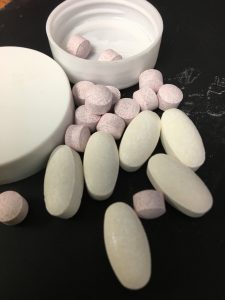
by Melanie Taylor | Mar 11, 2020
This month brings awareness and education about the importance of our kidneys in maintaining a healthy life. Kidney function is unique because you may not notice the symptoms until the function is already far gone. The CDC reports chronic kidney disease is a condition that 1 in every 7 adults (age 18 or older) in the United States has, as well as people with end stage renal disease who need dialysis or a kidney transplant.
How do your kidneys keep you healthy?
- Help remove excess fluid levels in the body.
- Make vitamins that control growth.
- Activate Vitamin D for healthy bones.
- Filter wastes from the blood.
- Control the production of red blood cells.
- Release hormones that help regulate blood pressure.
- Help regulate blood pressure, red blood cells, and the amount of certain nutrients in the body, such as calcium and potassium.
There are many complications associated with kidney disease. They include cardiovascular disease, nerve damage, heart attack, weak bones, high blood pressure, stroke, anemia/low red blood cell count and of course kidney failure.

Speak openly with your doctor about any concerns you may have regarding your health. (Photo source: Tyler Jones, UF/IFAS)
The main risk factors for kidney disease and the problems associated with it are high blood pressure, diabetes, family history, and being 60 years old and above. Out of these four problems, two of them – high blood pressure and diabetes – may be managed by maintaining a healthy lifestyle, taking medications as prescribed, regular visits to your doctor and exercise. If you have been diagnosed with either of these two, you need to regularly monitor your blood pressure and glucose levels, take medications if prescribed, and speak openly with your doctor about concerns or questions you may have. Family history and being over the age of 60 are not issues you can control, but you can strive to live a healthy lifestyle and regularly have blood work drawn so your doctor can help catch any issues that are becoming a problem. Learning to maintain and follow your doctor’s orders will go a long way to keeping you and your kidneys healthy longer.
What are the symptoms you may notice if you are experiencing kidney problems?
- Swelling in your face, hands, abdomen, ankles, and feet.
- Blood in your urine or foamy urine.
- Puffy eyes.
- Difficult, painful urination.
- Increased thirst.
- Fatigue.
If you notice any of these problems or are just concerned because of family history, your family doctor can order the blood work to check your kidney function. If you find out you are experiencing kidney problems you should see a nephrologist – a kidney specialist.
Although many people ignore the importance of their kidneys, they play a very important part in our daily bodily functions in regulating minerals, fluids, blood pressure, and so much more. Striving to maintain a healthy lifestyle will help to ensure your kidneys keep working hard for you. Be sure to show your kidneys some love this March to celebrate National Kidney Month.
Sources:
National Kidney Foundation – https://www.kidney.org/
Center for Disease and Prevention – https://www.cdc.gov/

by Laurie Osgood | Mar 3, 2020
Friendships are an important part of life, and friendships can have a tremendous impact on our personal well-being and overall mental and physical health. Social isolation can lead to depression and loneliness. The relationships that we build with our family and friends can affect the quality of the friendships that we develop over our lifetimes. Some people thrive socially and develop deep, meaningful connections with others, while others only maintain distant friendships. However, it is important for us to help our children learn to develop these important social skills. Researchers have long documented links between the quality of relationships between family members and their relationships with their peers. Participation in team sports can have lasting benefits, including responsible social behaviors, good sportsmanship, strong leadership skills, academic success, and self-confidence.

Parents can form lasting friendships while supporting their kids in youth sports. (Photo source: Laurie Osgood, UF/IFAS Extension)
When It Comes to Youth Sports, Parents Don’t Always Behave Themselves.
As team sports become more competitive, there is increased attention placed on the negative aspects of team sports, mainly parental expectations and behavior. Having spent a large part of my life sitting in the stands watching my children play team sports, I have developed deep, long-lasting friendships with the parents of my children’s friends. These friendships are often maintained between parents long after our children put away their soccer cleats. Of course, overbearing parents can take the fun out of sports for our children. Many children drop out of team sports because they are no longer having fun and participation becomes too stressful.
What Can Parents Do to Help Their Kids Develop Positive, Warm Friendships?
- Continue to nurture and support the friendships that you have established throughout your lifetime.
- Be a good sports parent by showing support to your child.
- Model good friendship skills. This will help youth understand social competence.
- Be happy and have fun at your child’s competitions.
- Minimize pressure & don’t coach your child from the sidelines.
- Nurture the youth’s ambitions, but don’t let them get too wrapped up in the competitiveness.
- Be respectful of your child’s teammates, coach, opponents, and the game’s rules and traditions.
It is our job as parents to teach our children social skills to help them grow as individuals, not just athletes. As parents it is our job to nurture their emotional and physical development. Even as adults we must continue to stay connected with our friends and families. As we grow older, good friendships can prevent loneliness, improve our health, boost our well-being, and even add years to our lives.

by Dorothy C. Lee | Feb 3, 2020
February is National Heart Health Awareness Month. On February 7th join the nation and wear red to show support and awareness for women and heart disease.
National Heart Awareness Month is sponsored by the American Heart Association. It is designed to provide the public with information that could lead to a more healthful lifestyle and reduce heart disease.

Go Red for Women’s Heart Health
Photo Source: Dorothy Lee
The Centers for Disease Control and Prevention estimates that 610,000 people die of heart disease in the United States yearly. According to the American Heart Association heart disease and stroke kills one in three women yearly in the United States. Heart disease is a silent killer. It often strikes without warning.
Know the risk factors and symptoms of heart disease. Risk factors are family history of heart disease, diabetes, poor diet, high blood pressure and cholesterol levels, excessive alcohol use, smoking and physical inactivity.
The diet choices we make today are important to our nutritional well-being tomorrow. A diet low in saturated fat and cholesterol, high in fruits and vegetables, and grain products that contain some type of dietary fiber may reduce the risk of heart disease.
Our health is our most precious possession. A healthy diet is only one part of a heart healthy lifestyle. Physical activity is another important component. The American Heart Association physical activity guidelines recommend some type of aerobic exercise daily. Walking, dancing, biking, swimming, or gardening are good examples. Be sure to consult your physician before starting any exercise program.
We are all concerned about maintaining good health. Take steps to a healthier heart. Develop good eating habits based on moderation and variety, plus physical activity can help keep and even improve your health. So, reach in the back of the closet and find that little red dress and wear it this year on Friday, February 7th in support of Women’s Heart Healthy Awareness. Go Red!
Resource: www.heart.org
For further information, contact:
Dorothy C. Lee, C.F.C.S.
UF/IFAS Extension Escambia County
3740 Stefani Road
Cantonment, FL 32533-7792
(850) 475-5230
dclee@ufl.edu

by Heidi Copeland | Jan 29, 2020
We have a silent killer amongst us. It is the use and abuse of opioids! In fact, opioid use and abuse is a classified epidemic.

Too many pills?
Photo Source: Heidi Copeland
The opioid epidemic refers to the growing number of deaths and hospitalizations due to opioid use.
According the Centers for Disease Control and Prevention (CDC), overdose deaths from opioids, including prescription opioids, heroin, and synthetic illicit opioids (like fentanyl), have increased almost six times since 1999.
What is the appeal of opioid abuse? In the 2015 National Survey on Drug Use and Health (NSDUH), 11.5 million adults who abused prescription pain relievers at least once in the past year were asked their reasoning for misuse. The top answer included to relieve physical pain! (63.4%) Other reasons included relaxation, relieve tension, feel good, help with sleep, or to increase or decrease the effects of other drugs (Lipari, Williams, & Van Horn 2017).
There is no doubt that opioids are an effective pain reliever, however, the speed in which this abusive opioid epidemic has grown provides plenty of reasons everyone should be concerned. An opioid addiction can endanger the safety of each of us.
How did this epidemic begin? The epidemic stems from the late 1990’s. At the time, no one knew how quickly misuse of a prescription opioid could lead to an addiction. In a relatively short period of time opioid overdose rates, both prescription opioids as well as illicit synthetic opioids, skyrocketed. In the year 2017 alone, more than 47,000 Americans died as a result of an opioid overdose and 1.7 million individuals suffered from substance use relating to pain killers as a whole (NIH 2018).
The epidemic is also causing serious repercussions socially and economically. The Center for Disease Control and Prevention (CDC) estimates the total cost of opioid abuse to be a $78.5 billion a year and is a burden to our economy. Additional issues associated with opioid misuse can include loss of worker productivity, addictive behavior, and higher crime rates (Rich, Kornfield, Mayes, & Williams 2019).
Every individual can positively contribute to ending this epidemic. Get educated. Be aware of the signs of someone struggling with an opioid abuse and addiction. Recognize character traits associated with opioid abuse like loss of control, preoccupation with drug use, and willingness to continue using despite the negative consequences.
There are promising practices and resources to help end this epidemic. The U.S. Department of Health and Human Services (HHS) is directing their attention to this epidemic with efforts focused on (NIH 2018):
- improving access to treatment and recovery services
- strengthening our understanding of the epidemic through public health surveillance
- providing support for research on pain and addiction
- advancing alternative practices for controlling pain
As well, both National and State Prescription Drug Monitoring Programs (PDMP) are promising drug prevention tools.
Never doubt that a small group of thoughtful committed citizens can change the world; indeed, it’s the only thing that ever has. (Margaret Mead) Together, we can all do our part stop this epidemic.
Bailee Hurd, University of Florida Health Education Intern
Bonner, Michael. “’Opioids Are the Health Crisis of This Generation’.” Southcoasttoday.com, Southcoasttoday.com, 24 Sept. 2017, www.southcoasttoday.com/news/20170922/opioids-are-health-crisis-of-this-generation.
Lipari, Rachel, et al. “Why Do Adults Misuse Prescription Drugs?” Https://Www.samhsa.gov/Data/Sites/Default/Files/report_3210/ShortReport-3210.Html, Substance Abuse and Mental Health Services Administration, 27 July 2017, www.samhsa.gov/data/sites/default/files/report_3210/ShortReport-3210.html.
National Institute on Drug Abuse. “Opioid Overdose Crisis.” NIDA, 22 Jan. 2019, www.drugabuse.gov/drugs-abuse/opioids/opioid-overdose-crisis.
“Opioid Overdose.” Centers for Disease Control and Prevention, Centers for Disease Control and Prevention, 18 Oct. 2019, www.cdc.gov/drugoverdose/.
Rich, Steven, et al. “A New Look at How the Opioid Epidemic Evolved.” The Washington Post, WP Company, 23 Dec. 2019, www.washingtonpost.com/graphics/2019/investigations/opioid-pills-overdose-analysis/.

by Angela Hinkle | Oct 22, 2019
Delicious, nutritious, and super helpful for today’s needs, peanut butter is a great addition to your shopping cart. But it’s more than just a tasty and healthy food that also helps those in need (more on that below). Pound for pound, peanut butter saves.

Nutty for Peanut Butter
Photo Source: Angela Hinkle
Compared to a pound of ground beef, a pound of peanut butter saves:
- Money at the grocery store. A pound of peanut butter currently comes in at around $2.50. A pound of ground beef will run you around $3.82.
- Time. It takes about 2-3 minutes to make a peanut butter and jelly sandwich. A burger at home will take you anywhere from about 8-15 minutes to prepare.
- Environmental costs. If you make a peanut butter and jelly sandwich for lunch instead of a hamburger, you can save 2.5 pounds of carbon dioxide, 133 gallons of water, and 24 square feet of crop land.
- Saturated fat. That’s the kind that tends to clog up arteries and cause health problems. Eating the PB&J gives you about 3 grams. You consume about 10 grams of saturated fat in a 90% lean quarter pound hamburger.
- Utilities. No gas, coals, or electricity is required to cook or safely store peanut butter.
- Hunger. Families in hardship situations often need help from food pantries. The most requested item from these pantries is – yes, you guessed it – peanut butter. It is shelf stable so you don’t have to worry about keeping it cold or heating it up. People like it. And it is a healthy plant-based food with fiber and oleic acid – a healthier monounsaturated fat.
Maybe you’re like me – you like a really good, juicy all-beef burger. Every once in a while, sure. But pound for pound, peanut butter really can save the day.
Here’s how you can help with the local hunger part:
- Buy peanut butter. Look for BOGOS (Buy One Get One Free Sales). Keep one for yourself. Then…
- Now through November 27, donate unopened jars of peanut butter for the Peanut Butter Challenge. Check with your Florida Panhandle UF/IFAS Extension Office for collection sites.
- All collected peanut butter will be given to local food pantries to assist hungry families in need.
So save, save, save with peanut butter. And help save a family from hunger.
Check out 2019 Peanut Butter Challenge for additional information.
Resources: https://foodtank.com/news/2013/12/why-meat-eats-resources/ and https://www.farmprogress.com/peanut/peanut-s-environmental-footprint-stretches-beyond-farm










